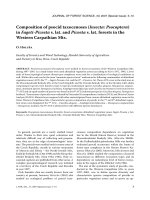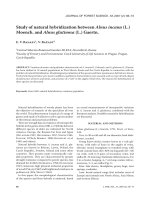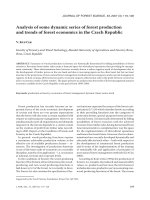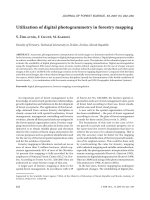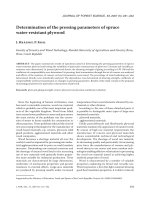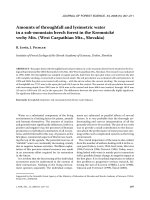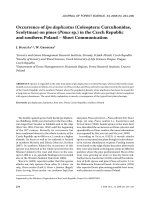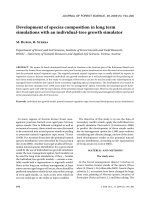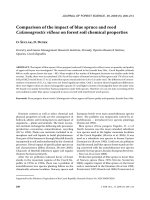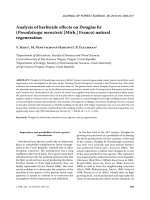Báo cáo lâm nghiệp: "Micrografting of mature stone pine (Pinus pinea L.) trees" pps
Bạn đang xem bản rút gọn của tài liệu. Xem và tải ngay bản đầy đủ của tài liệu tại đây (799.43 KB, 3 trang )
843
Ann. For. Sci. 61 (2004) 843–845
© INRA, EDP Sciences, 2005
DOI: 10.1051/forest:2004081
Note
Micrografting of mature stone pine (Pinus pinea L.) trees
Millán CORTIZO
a
, Pablo ALONSO
a
, Belén FERNÁNDEZ
a
, Ana RODRÍGUEZ
a
, Maria Luz CENTENO
b
,
Ricardo J. ORDÁS
a
*
a
Unidad de Fisiología Vegetal, Departamento de Biología de Organismos y Sistemas, Universidad de Oviedo, C/ Catedrático Rodrigo Uría s/n,
33071 Oviedo, Spain
b
Departamento de Biologia Vegetal, Universidad de León, Spain
(Received 1 December 2003; accepted 31 August 2004)
Abstract – This paper describes an in vitro micrografting method for selected mature Pinus pinea L. trees. Needle fascicles of five selected
clones were micrografted onto hypocotyls of two weeks-old germinated isolated embryos. Fascicle meristems outgrowth was recorded after
one month of culture and the performance of the clones assayed was evaluated. Clones behave statistically different in establishment and
development rates. Overall success of our protocol reached 43% of the graftings made.
micrografting / micropropagation / conifer / in vitro grafting / Pinus pinea
Résumé – Micro-greffage de clones sélectionnés de Pinus pinea L. Ce rapport décrit une méthode pour le greffage in vitro de Pinus pinea
L. Des brachyblastes de cinq clones ont été greffés sur embryons isolés germés, âgés de deux semaines. Le développement des méristèmes
fasciculaires a été quantifié pour chaque clone après un mois. Les pourcentages d’établissement et de développement sont statistiquement
différents pour les cinq clones. Le taux de succès du greffage réalisé par notre méthodologie s’élève à 43 %.
micro-greffage / micro-propagation / conifer / in vitro greffage / Pinus pinea
Stone pine (Pinus pinea L.) is one of the most important tree
species of the Mediterranean area. It has gained new attention
in the last years due to the rural development programs granted
by the European Union. Highly regarded owing to its ecological
and landscape value, it lives in zones with bad soils and a strong
summer drought. Stone pine has also a great economical impor-
tance, since it produces edible and valuable pine nuts or “piñon”.
This makes many aspects of its management similar to an agro-
nomic tree. The existence of a wide potential for improvement
and the great economic value of the pine nuts give good reasons
for genetic breeding programs. These programs are based on
the identification of excellent genotypes by establishing clonal
banks with different provenances. The stone pine pruning pos-
sibilities are limited, as this species does not root as cutting, nor
does it allow woody grafting. Thus these banks have to be estab-
lished by grafting scions obtained from long shoot terminal
buds at the precise time of spring flush initiation, or from other
soft tissues like needled dwarf shoots [8]. Although it is easy
to perform by skilled workers, grafting has a high percent of
failure, leading to loss in time and land use, raising costs and
making difficult to set up plantations.
In this paper we report the development of a micrografting
protocol which, combined with the P. pinea improvement pro-
gram, could allow a rapid build-up of plantations for genotype
selection trials, improving the current situation of P. pinea
breeding programs and reducing its costs.
Two weeks-old in vitro germinated embryos from stone pine
(P. pinea L.) seeds were used as rootstocks. Seeds obtained
from open pollinated trees in Spanish natural stands (ES-23/01
provenance) were provided by the Servicio de Material
Genético del Ministerio de Medio Ambiente (Spain).
Seeds were surface sterilised by immersion in 7.5% (v/v)
hydrogen peroxide solution for 45 min followed by three rinses
in sterile double distilled water. After sterilisation seeds were
kept in Petri dishes over a moistened sterile filter paper for 48 h
at 4 ºC in darkness according to Humara et al. [6]. Each seed
was dissected under aseptic conditions and the embryo trans-
ferred to glass test tubes (24 mm Ø × 95 mm) onto a cellulosic
“Sorbarod
TM
” plug imbibed with 5 mL of culture medium con-
sisting of half strength macronutrients, micronutrients and vita-
mins of Woody Plant Medium [7] and supplemented with
10gL
–1
sucrose. The pH was adjusted to 6.5 prior to autoclav-
ing. Embryos were maintained in a Sanyo Growth Cabinet
MLR-350 (Japan) under a 16 h photoperiod under a photosyn-
thetic photon flux of 100 µmol m
–2
s
–1
provided simultaneously
by cool white light (Standard F36W/133 Sylvania, Germany)
and Grow-Lux (F36W/GROT8 Sylvania, Germany) fluores-
cent lamps at 25/19 °C light/dark. Under these conditions most
* Corresponding author:
844 M. Cortizo et al.
of the embryos developed within 2 weeks into 1–2 cm tall young
seedlings suitable for grafting. Whole seeds were not used since
their germination is not synchronous and have proven very dif-
ficult in vitro, furthermore by using only the embryo we min-
iaturize the seedling allowing its culture in glass tubes. Seedlings
originated from whole seeds grow too fast and are unnecessar-
ily big for micrografting purposes.
Five selected genotypes were used in this study, needle fas-
cicles were obtained from twigs from the lower part of the
crown of eleven-year old, grafted stone pines in the clone bank
B23PH1 of the “Centro Nacional de Mejora Genética Puerta
de Hierro”, Madrid (Spain). This clone bank was established
in 1992 with scions from plus trees selected for their superior
cone yield in natural stone pine stands of the Catalan prove-
nance (ES-23/06). Branches of these five superior clones, num-
bers 15, 21, 24, 36 and 54, were collected in February, March,
April, May and July 2003 and stored no more than 20 d in plastic
bags in darkness at 4 ºC until use. The day before grafting,
branches were kept under running tap water overnight, and dis-
infected according to Ordás et al. [10]. Micrografting material
was kept in antioxidant solution made of 100 mg L
–1
ascorbic
acid and 150 mg L
–1
citric acid to prevent phenolic oxidation [10].
Micrografting procedure was carried out as follows. Whole
brachyblasts in arrested growth (developed during the 2002
growth season) were dissected under aseptic conditions and cut
leaving a 1 cm long basal part. After the removal of the sheath
of the needle a cut was made to excise the brachyblast, and then
a V-shaped cut of 2 mm orthogonal to the plane of the needle
was performed (Fig. 1a). We used needles instead of isolated
fascicle meristems because they are easier to manipulate and
to avoid bud dehydration while having a sufficient level of min-
iaturization [1]. All manipulations were handled over sterile fil-
ter paper moistened with the antioxidating solution referred
before with the aid of a physician magnifying glass. Seedlings
were decapitated 1–2 mm below the insertion of the cotyledons
and a 2–3 mm longitudinal cut was made. Scions were inserted
into the split and the edges of the hypocotyl were held together
with a ring made of 1 mm wall chromatography tubing (Fig. 1a).
The cellulosic plug used as physical support allowed an easier
manipulation without damaging rootstock, which has been
proven to be detrimental according to Monteuuis [9]. The use
of agar blocks to prevent rapid and intense dehydration of the
scion [5] was also tested but no significant improvements were
obtained (data not presented).
Micrografted needles were cultured in the same conditions
as for germination. A completely randomised design with sub-
sampling was applied using a minimum of 15 explants per clone
and experiment. Data account for the total of five experiments
carried out in February, March, April, May and July 2003. Data
were collected 30 days after grafting, and the percentages of
contamination, established and developed grafts were calcu-
lated. We define establishment as micrografts that survive after
30 days of culture and developed micrografts as those that
exhibit a visible needle fascicle bud outgrowth. Contaminated
explants were discarded and excluded from further analysis.
Fungal contamination appeared in 40% of the tubes and was
located mainly in the scions. Quantitative data (number of
established/developed grafts) were analysed using Kruskall-
Wallis H test for n independent group analysis and Mann-Whitney
U test for 2 independent pairs. All statistical analyses were per-
formed at the 5% level using the STATISTICA
®
software.
Established micrografts showed a visible intermediate cal-
lus within the first week of culture (Fig. 1a). Cells start to pro-
liferate in the rootstock and then in the scion. Callus bridge
stops to proliferate in 10–15 days, as soon as the graft cleft is
filled (Fig. 1b). Fascicular bud development can be seen under
the microscope in the second week and becomes clearly visible
after three weeks (Fig. 1c). After four weeks no new developed
grafts appear, although established scions remained alive until
they were discarded (six months). Six weeks after the graft was
made the culture medium was replenished by adding 2 mL of
medium under aseptic conditions. For acclimatisation experi-
ments at least 15 micrografts per tested month of collection
were transferred to a sterile peat-perlite (1:4 v/v) mixture eight
to ten weeks after micrografting and grown under decreasing
initially high humidity allowing its transfer to normal humidity
conditions one week later. Survival of micrografts after two
months in nursery reached 98%. No plagiotropic growth was
observed in micrografted plants at this point and rootstock has
a well developed root system capable of sustaining further
shoot outgrowth (Fig. 1d).
Average developmental success (out of contaminations) of this
protocol is 43%, accounting for the 5 clones assayed, achieving
a 61% with clone 15 (Tab. I). Clones behave statistically different
both in establishment and development (Tab. I). It is noticeable
that development is highly clone dependent, while establishment
is more homogeneous. We have found a seasonal effect on
Figure 1. Different stages in P. pinea micrograft development: (a)
one week old micrograft, (b) intermediate callus of a two weeks old
micrograft, (c) three weeks old developed bud, (d) five months old
grafted plantlet.
Micrografting of mature stone pine trees 845
development (Fig. 2). This should be considered carefully, it
could be due to physiological differences or, more likely, to the
little optimisations of the procedure and acquired dexterity of
manipulator. Even though success may vary from laboratory to
laboratory notwithstanding genotype influence, this technique
has proven to be efficient with all the material tested. Although
there is a great variability in micrografting methods our tech-
nique showed a higher efficiency than the reported values in
P. radiata [4], possibly due to the different rootstock used,
since juvenile seedlings are more suitable for grafting than
older or unrooted material as reported by Monteuuis [9]. It is
noticeable that using fascicular buds, the present protocol gives
similar results to those obtained with apical meristems in other
conifers such as Larix [3] and Picea [9]. The use of needles
instead of apical buds is more practical as they are more abun-
dant and easier to manipulate.
While micrografting is not practical on a large scale for a
majority of species [2], it can be very useful in stone pine breed-
ing programs, especially for establishing field trails and seed
orchards. In this context our approach can be used to evaluate
scion-rootstock interaction easily by using half sibling seeds.
Traditional grafting of stone pine is done by skilled workers
(about 120 grafts/day) and can be performed only during few
weeks in spring, limited by growth phenology of rootstocks and
scions. Although micrografting is made at lower rate (50 grafts/
day), it has proven effective before, during and after spring
flush (Fig. 2), overcoming these seasonal limitations and thus
having a potentially greater output. Actually, the main problem
of traditional tip grafting consists in the low success rate com-
bined with this temporal limitation. The process implies also a
delay of several years: rootstocks are normally several years
old, nursery-grown seedlings, and grafting in open-air condi-
tion may imply less than 40% of successful grafts (adverse
meteorological post-grafting conditions can produce even
100% failures (Sven Mutke, personal communication)). In vitro
micrografting of a selected tree can be made in a faster way
reducing traditional costs by saving nursery space and reducing
scion cost, since each twig can provide 20 to 40 micrografting
suitable needles. Ex vitro acclimated plants are to be tested to
determine its real agronomical value. To our knowledge this is
the first report on in vitro grafting method for Pinus pinea.
Acknowledgements: The authors sincerely thank Sven Mutke Reigneri
for his excellent scientific advice and Jaime M. Humara for his English
revision. Millán Cortizo and this work were supported by “Consejería
de Medio Ambiente de la Junta de Castilla y León” and “Ministerio de
Ciencia y Tecnología de España” (MCT-02-AGL-00867), respectively.
REFERENCES
[1] Bonga J.M., von Aderkas P., Rejuvenation of tissues from mature
conifers and its implications for propagation in vitro, in: Ahuja
M.R., Libby W.J. (Eds.), Clonal Forestry, Vol. 1, Springer-Verlag,
Berlin Heidelberg New York, 1993, pp. 182–200.
[2] Bonga J.M., von Aderkas P., Influencing micropropagation and
somatic embryogenesis in mature trees by manipulation of phase
change, stress and culture environment, Tree Physiol. 20 (2000)
921–928.
[3] Ewald D., Kretzschmar U., The influence of micrografting in vitro
on tissue culture behavior and vegetative propagation of old Euro-
pean larch trees, Plant Cell Tissue Organ Cult. 44 (1996) 249–252.
[4] Fraga M., Cañal M.J., Aragonés A., Rodríguez R., Factors involved
in Pinus radiata D. Don. micrografting, Ann. For. Sci. 59 (2002)
155–161.
[5] Jonard R., Micrografting and its applications to tree improvement,
in: Bajaj Y.P.S. (Ed.), Biotechnology in agriculture and forestry, Vol. 1,
Springer-Verlag, Berlin Heidelberg New York, 1986, pp. 31–48.
[6] Humara J.M., Marín M.S., Parra F., Ordás R.J., Improved effi-
ciency of uidA gene transfer in stone pine (Pinus pinea) cotyledons
using a modified binary vector, Can. J. For. Res. 29 (1999) 1627–
1632.
[7] Lloyd G.B., McCown B.H., Commercially-feasible micropropaga-
tion of mountain laurel, Kalmia latifolia, by use of shoot-tip culture,
Proc. Inter. Plant Prop. Soc. 30 (1980) 421–427.
[8] Mutke S., Gordo J., Gil L., The stone pine breeding program in Castile-
Leon (central Spain), FAO-CIHEAM Nucis Newsletter, 9 (2000)
50–55.
[9] Monteuuis O., Effect of technique and darkness on the success of
meristem micrografting of Picea abies, Silvae Genet. 43 (1994)
91–95.
[10] Ordás R.J., Tavazza R., Ancora G., In Vitro morphogenesis in the
globe artichoke (Cynara scolymus L.), Plant Sci. 71 (1990) 233–237.
Table I. Rates of P. pinea micrograft establishment and development in the five clones assayed after four weeks of culture.
Clone
15 21 24 36 54 Total
Ratio % Ratio % Ratio % Ratio % Ratio % Ratio % p-value
a
Established/total 51/59 86 49/67 73 50/73 68 44/64 69 30/55 55 224/318 70 0.0372
Developed/total 36/59 61 33/67 49 19/73 26 32/64 50 19/55 35 139/318 43 0.0005
Developed/established 36/51 71 33/49 67 19/50 38 32/44 73 19/30 63 139/224 62 0.0015
a
Kruskall-Wallis H test p-value.
Figure 2. Effect of date of collection in P. pinea micrografting. Dif-
ferent letters indicate significant differences with Mann-Withney U
test at α = 0.05.
